Management Accounting Report: Costing Systems and Analysis
VerifiedAdded on 2020/10/23
|8
|2192
|156
Report
AI Summary
This report provides a comprehensive analysis of management accounting principles, focusing on job costing, activity-based costing (ABC), work in progress, and finished goods inventory. The report begins with an introduction to management accounting, explaining its role in decision-making and operational efficiency. It then delves into the job costing system, explaining its suitability for companies like Connectta Ltd., which produce various products. The report includes calculations for work in progress inventory, finished goods, and manufacturing overhead, including examples of over-applied overhead. It also discusses accounting treatments for under-applied and over-applied overhead, and highlights the benefits of the ABC system in overcoming deficiencies of traditional job costing. The conclusion emphasizes the importance of management accounting in internal control and decision-making, and the report references several academic sources to support its findings.
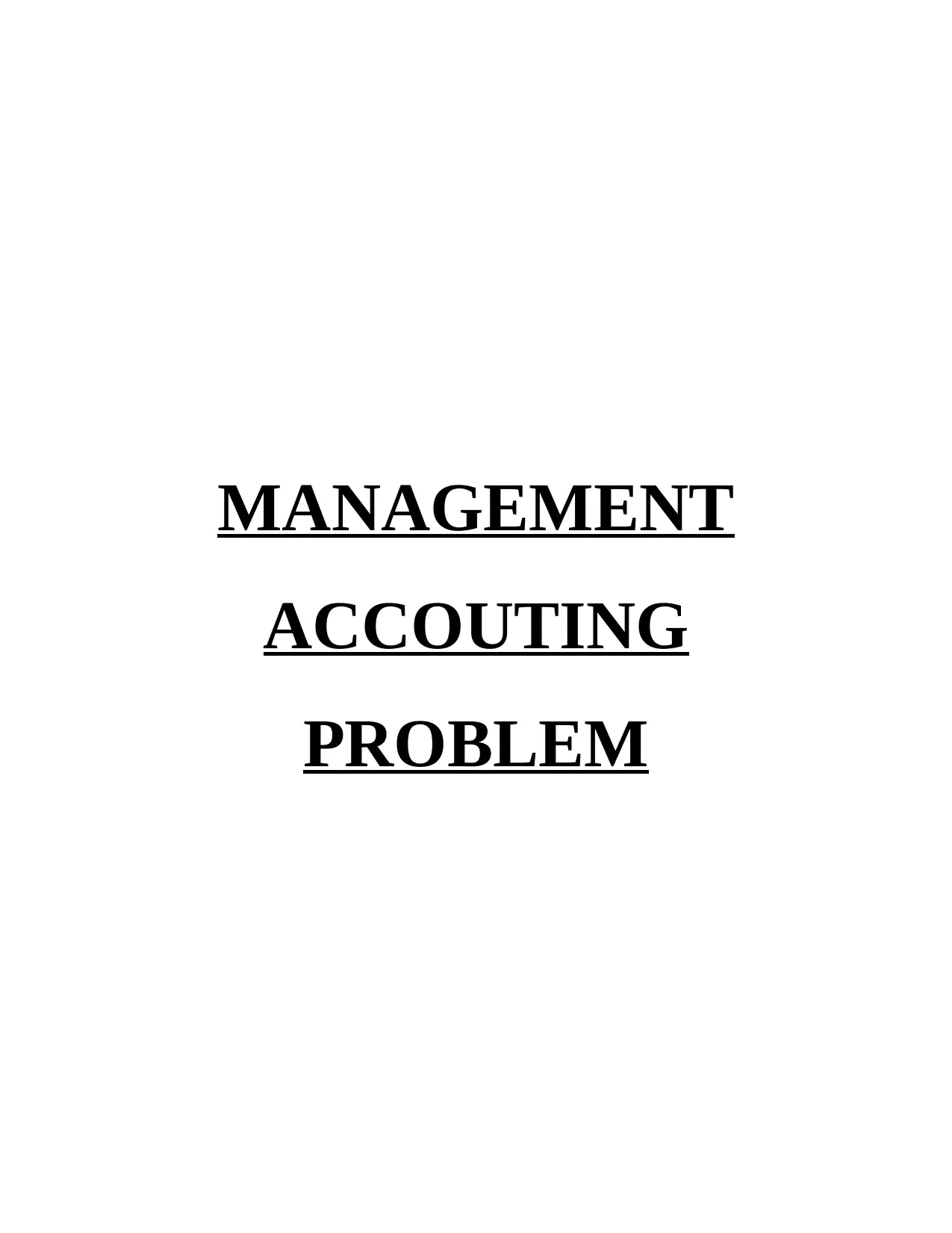
MANAGEMENT
ACCOUTING
PROBLEM
ACCOUTING
PROBLEM
Paraphrase This Document
Need a fresh take? Get an instant paraphrase of this document with our AI Paraphraser
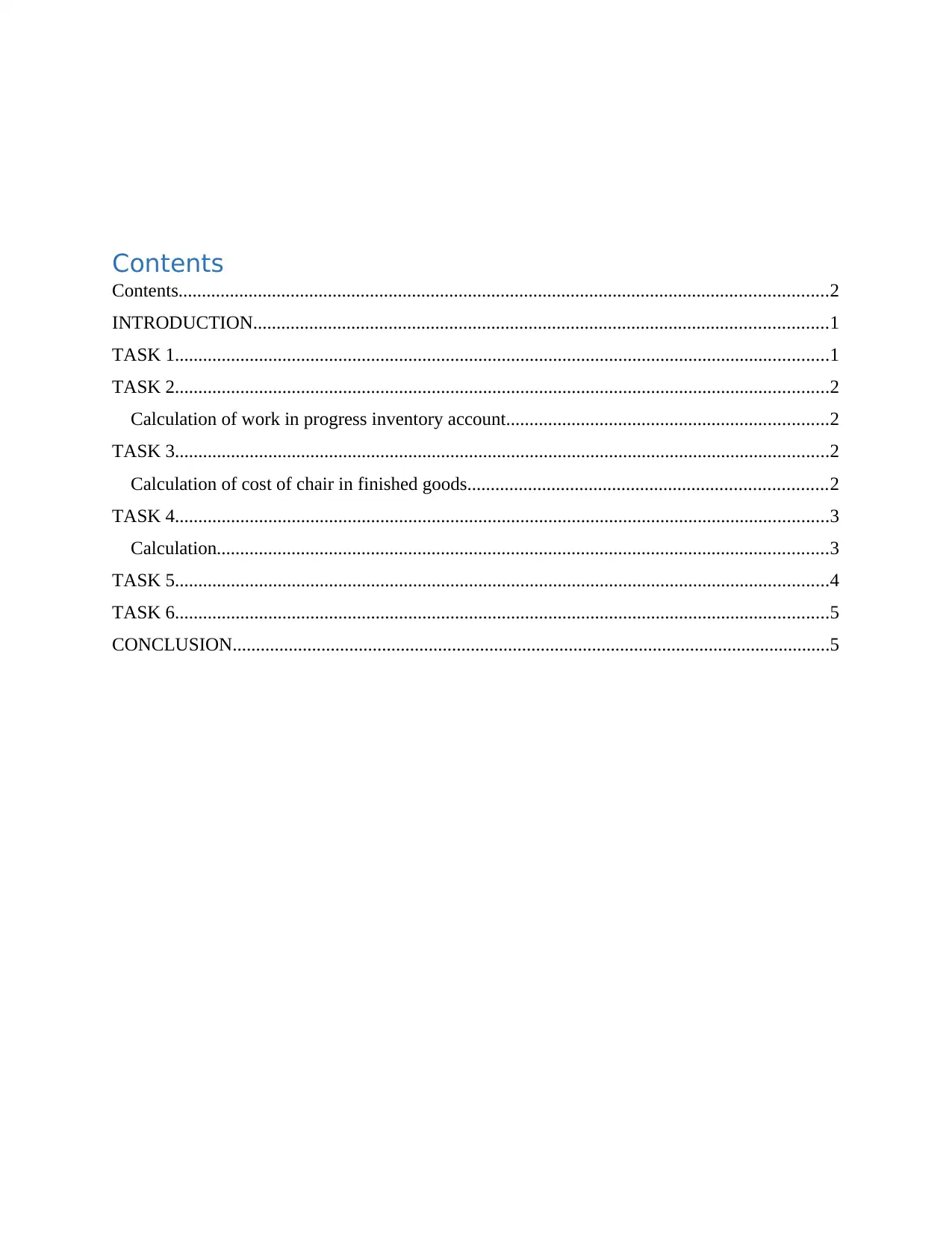
Contents
Contents...........................................................................................................................................2
INTRODUCTION...........................................................................................................................1
TASK 1............................................................................................................................................1
TASK 2............................................................................................................................................2
Calculation of work in progress inventory account.....................................................................2
TASK 3............................................................................................................................................2
Calculation of cost of chair in finished goods.............................................................................2
TASK 4............................................................................................................................................3
Calculation...................................................................................................................................3
TASK 5............................................................................................................................................4
TASK 6............................................................................................................................................5
CONCLUSION................................................................................................................................5
Contents...........................................................................................................................................2
INTRODUCTION...........................................................................................................................1
TASK 1............................................................................................................................................1
TASK 2............................................................................................................................................2
Calculation of work in progress inventory account.....................................................................2
TASK 3............................................................................................................................................2
Calculation of cost of chair in finished goods.............................................................................2
TASK 4............................................................................................................................................3
Calculation...................................................................................................................................3
TASK 5............................................................................................................................................4
TASK 6............................................................................................................................................5
CONCLUSION................................................................................................................................5
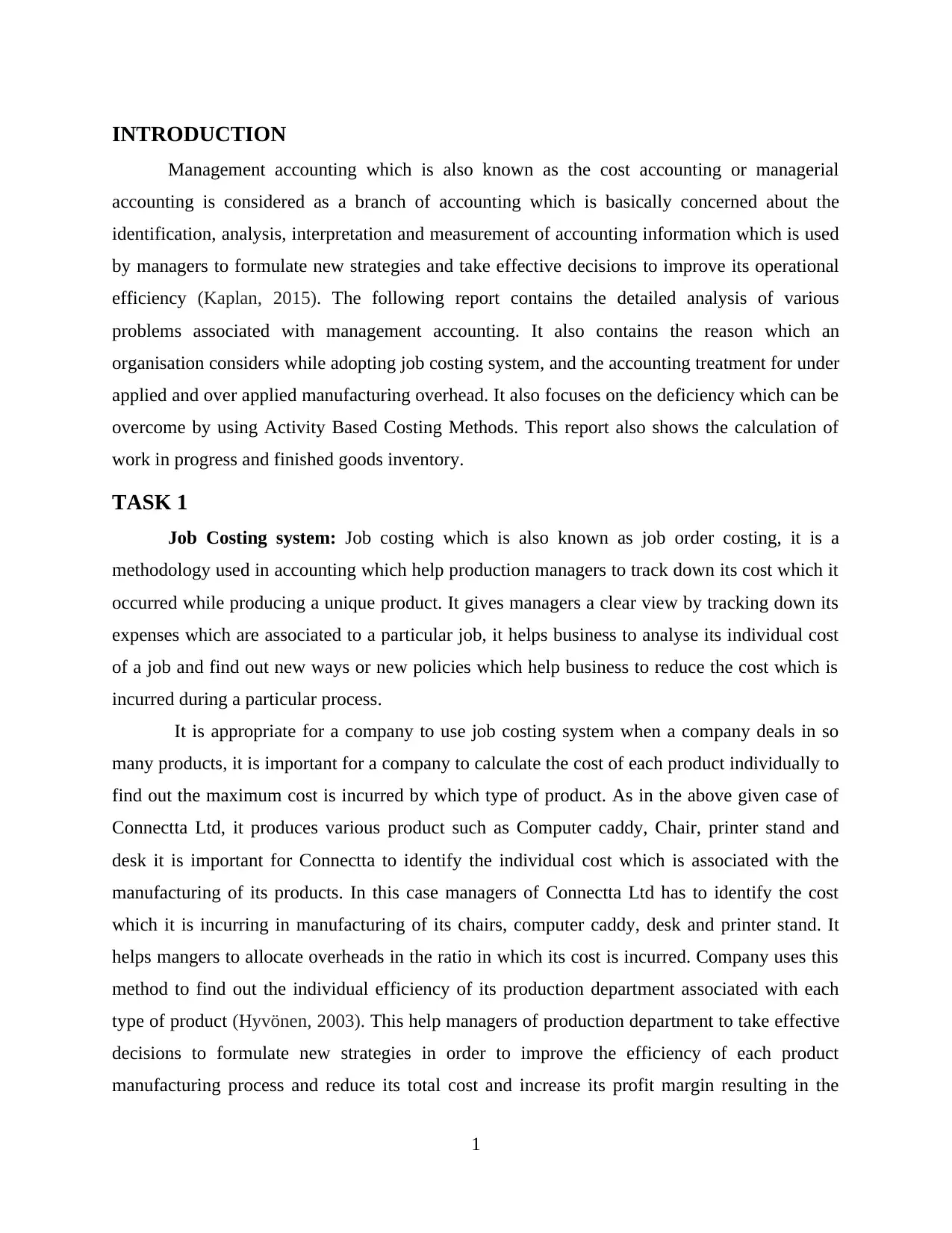
INTRODUCTION
Management accounting which is also known as the cost accounting or managerial
accounting is considered as a branch of accounting which is basically concerned about the
identification, analysis, interpretation and measurement of accounting information which is used
by managers to formulate new strategies and take effective decisions to improve its operational
efficiency (Kaplan, 2015). The following report contains the detailed analysis of various
problems associated with management accounting. It also contains the reason which an
organisation considers while adopting job costing system, and the accounting treatment for under
applied and over applied manufacturing overhead. It also focuses on the deficiency which can be
overcome by using Activity Based Costing Methods. This report also shows the calculation of
work in progress and finished goods inventory.
TASK 1
Job Costing system: Job costing which is also known as job order costing, it is a
methodology used in accounting which help production managers to track down its cost which it
occurred while producing a unique product. It gives managers a clear view by tracking down its
expenses which are associated to a particular job, it helps business to analyse its individual cost
of a job and find out new ways or new policies which help business to reduce the cost which is
incurred during a particular process.
It is appropriate for a company to use job costing system when a company deals in so
many products, it is important for a company to calculate the cost of each product individually to
find out the maximum cost is incurred by which type of product. As in the above given case of
Connectta Ltd, it produces various product such as Computer caddy, Chair, printer stand and
desk it is important for Connectta to identify the individual cost which is associated with the
manufacturing of its products. In this case managers of Connectta Ltd has to identify the cost
which it is incurring in manufacturing of its chairs, computer caddy, desk and printer stand. It
helps mangers to allocate overheads in the ratio in which its cost is incurred. Company uses this
method to find out the individual efficiency of its production department associated with each
type of product (Hyvönen, 2003). This help managers of production department to take effective
decisions to formulate new strategies in order to improve the efficiency of each product
manufacturing process and reduce its total cost and increase its profit margin resulting in the
1
Management accounting which is also known as the cost accounting or managerial
accounting is considered as a branch of accounting which is basically concerned about the
identification, analysis, interpretation and measurement of accounting information which is used
by managers to formulate new strategies and take effective decisions to improve its operational
efficiency (Kaplan, 2015). The following report contains the detailed analysis of various
problems associated with management accounting. It also contains the reason which an
organisation considers while adopting job costing system, and the accounting treatment for under
applied and over applied manufacturing overhead. It also focuses on the deficiency which can be
overcome by using Activity Based Costing Methods. This report also shows the calculation of
work in progress and finished goods inventory.
TASK 1
Job Costing system: Job costing which is also known as job order costing, it is a
methodology used in accounting which help production managers to track down its cost which it
occurred while producing a unique product. It gives managers a clear view by tracking down its
expenses which are associated to a particular job, it helps business to analyse its individual cost
of a job and find out new ways or new policies which help business to reduce the cost which is
incurred during a particular process.
It is appropriate for a company to use job costing system when a company deals in so
many products, it is important for a company to calculate the cost of each product individually to
find out the maximum cost is incurred by which type of product. As in the above given case of
Connectta Ltd, it produces various product such as Computer caddy, Chair, printer stand and
desk it is important for Connectta to identify the individual cost which is associated with the
manufacturing of its products. In this case managers of Connectta Ltd has to identify the cost
which it is incurring in manufacturing of its chairs, computer caddy, desk and printer stand. It
helps mangers to allocate overheads in the ratio in which its cost is incurred. Company uses this
method to find out the individual efficiency of its production department associated with each
type of product (Hyvönen, 2003). This help managers of production department to take effective
decisions to formulate new strategies in order to improve the efficiency of each product
manufacturing process and reduce its total cost and increase its profit margin resulting in the
1
⊘ This is a preview!⊘
Do you want full access?
Subscribe today to unlock all pages.

Trusted by 1+ million students worldwide
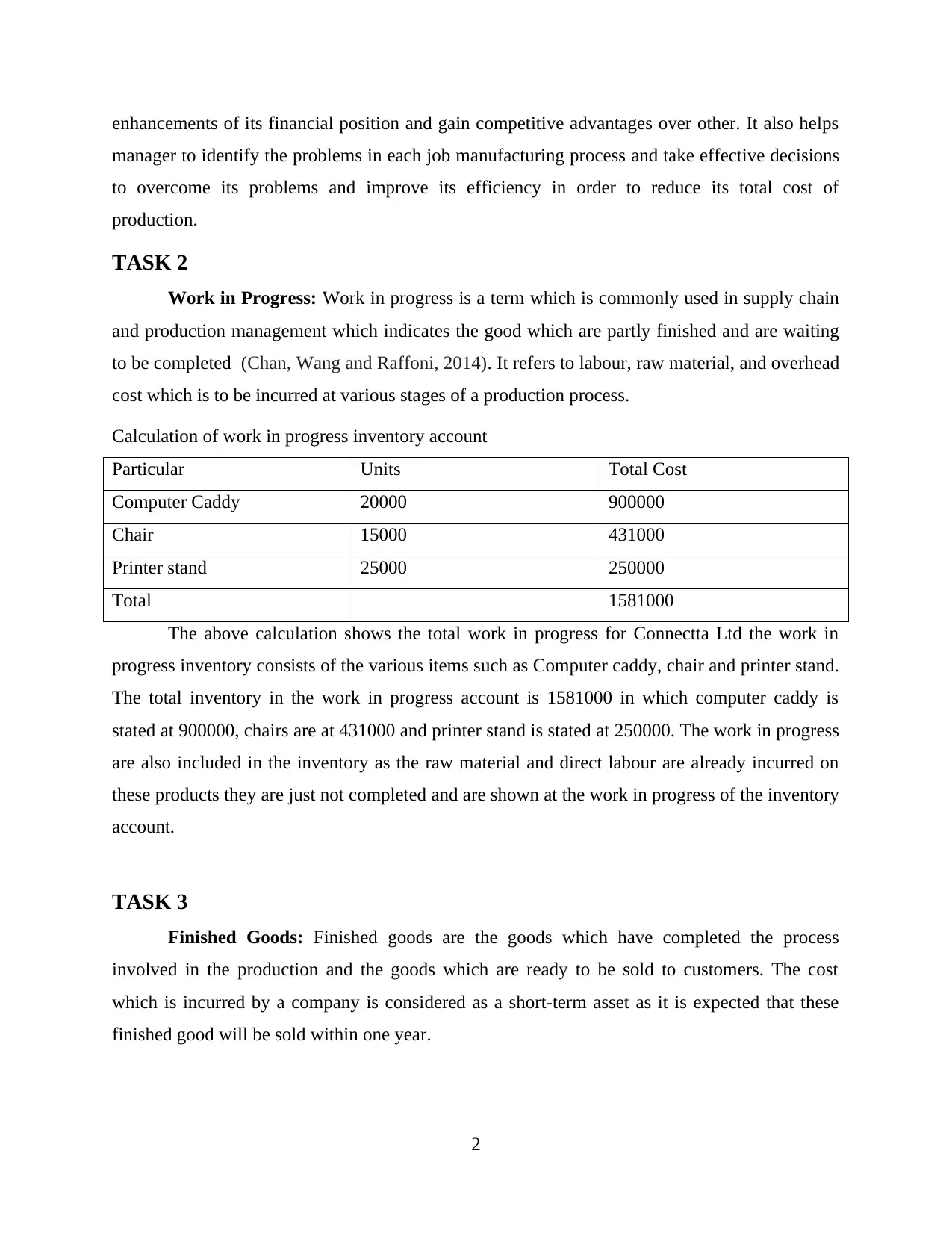
enhancements of its financial position and gain competitive advantages over other. It also helps
manager to identify the problems in each job manufacturing process and take effective decisions
to overcome its problems and improve its efficiency in order to reduce its total cost of
production.
TASK 2
Work in Progress: Work in progress is a term which is commonly used in supply chain
and production management which indicates the good which are partly finished and are waiting
to be completed (Chan, Wang and Raffoni, 2014). It refers to labour, raw material, and overhead
cost which is to be incurred at various stages of a production process.
Calculation of work in progress inventory account
Particular Units Total Cost
Computer Caddy 20000 900000
Chair 15000 431000
Printer stand 25000 250000
Total 1581000
The above calculation shows the total work in progress for Connectta Ltd the work in
progress inventory consists of the various items such as Computer caddy, chair and printer stand.
The total inventory in the work in progress account is 1581000 in which computer caddy is
stated at 900000, chairs are at 431000 and printer stand is stated at 250000. The work in progress
are also included in the inventory as the raw material and direct labour are already incurred on
these products they are just not completed and are shown at the work in progress of the inventory
account.
TASK 3
Finished Goods: Finished goods are the goods which have completed the process
involved in the production and the goods which are ready to be sold to customers. The cost
which is incurred by a company is considered as a short-term asset as it is expected that these
finished good will be sold within one year.
2
manager to identify the problems in each job manufacturing process and take effective decisions
to overcome its problems and improve its efficiency in order to reduce its total cost of
production.
TASK 2
Work in Progress: Work in progress is a term which is commonly used in supply chain
and production management which indicates the good which are partly finished and are waiting
to be completed (Chan, Wang and Raffoni, 2014). It refers to labour, raw material, and overhead
cost which is to be incurred at various stages of a production process.
Calculation of work in progress inventory account
Particular Units Total Cost
Computer Caddy 20000 900000
Chair 15000 431000
Printer stand 25000 250000
Total 1581000
The above calculation shows the total work in progress for Connectta Ltd the work in
progress inventory consists of the various items such as Computer caddy, chair and printer stand.
The total inventory in the work in progress account is 1581000 in which computer caddy is
stated at 900000, chairs are at 431000 and printer stand is stated at 250000. The work in progress
are also included in the inventory as the raw material and direct labour are already incurred on
these products they are just not completed and are shown at the work in progress of the inventory
account.
TASK 3
Finished Goods: Finished goods are the goods which have completed the process
involved in the production and the goods which are ready to be sold to customers. The cost
which is incurred by a company is considered as a short-term asset as it is expected that these
finished good will be sold within one year.
2
Paraphrase This Document
Need a fresh take? Get an instant paraphrase of this document with our AI Paraphraser
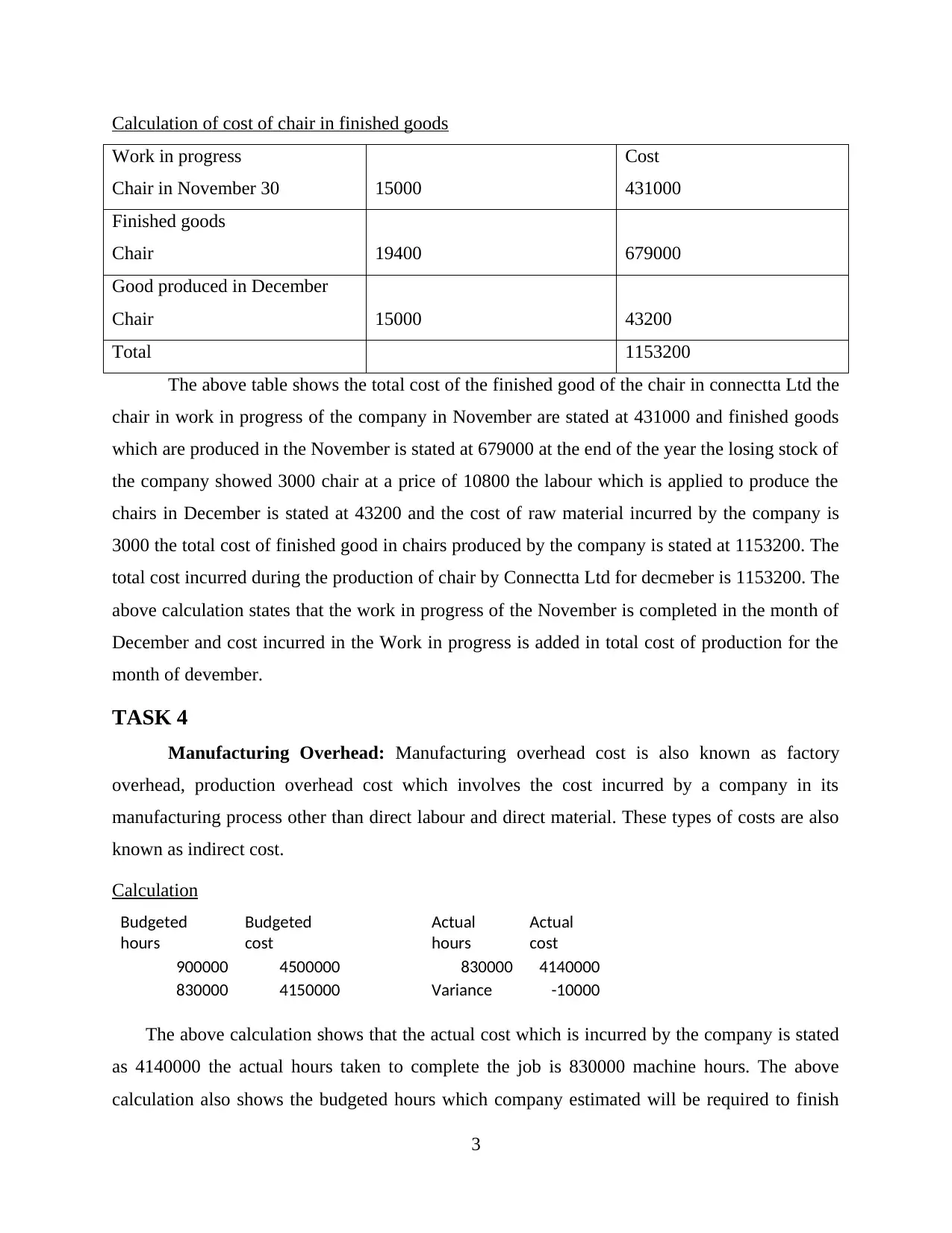
Calculation of cost of chair in finished goods
Work in progress
Chair in November 30 15000
Cost
431000
Finished goods
Chair 19400 679000
Good produced in December
Chair 15000 43200
Total 1153200
The above table shows the total cost of the finished good of the chair in connectta Ltd the
chair in work in progress of the company in November are stated at 431000 and finished goods
which are produced in the November is stated at 679000 at the end of the year the losing stock of
the company showed 3000 chair at a price of 10800 the labour which is applied to produce the
chairs in December is stated at 43200 and the cost of raw material incurred by the company is
3000 the total cost of finished good in chairs produced by the company is stated at 1153200. The
total cost incurred during the production of chair by Connectta Ltd for decmeber is 1153200. The
above calculation states that the work in progress of the November is completed in the month of
December and cost incurred in the Work in progress is added in total cost of production for the
month of devember.
TASK 4
Manufacturing Overhead: Manufacturing overhead cost is also known as factory
overhead, production overhead cost which involves the cost incurred by a company in its
manufacturing process other than direct labour and direct material. These types of costs are also
known as indirect cost.
Calculation
Budgeted
hours
Budgeted
cost
Actual
hours
Actual
cost
900000 4500000 830000 4140000
830000 4150000 Variance -10000
The above calculation shows that the actual cost which is incurred by the company is stated
as 4140000 the actual hours taken to complete the job is 830000 machine hours. The above
calculation also shows the budgeted hours which company estimated will be required to finish
3
Work in progress
Chair in November 30 15000
Cost
431000
Finished goods
Chair 19400 679000
Good produced in December
Chair 15000 43200
Total 1153200
The above table shows the total cost of the finished good of the chair in connectta Ltd the
chair in work in progress of the company in November are stated at 431000 and finished goods
which are produced in the November is stated at 679000 at the end of the year the losing stock of
the company showed 3000 chair at a price of 10800 the labour which is applied to produce the
chairs in December is stated at 43200 and the cost of raw material incurred by the company is
3000 the total cost of finished good in chairs produced by the company is stated at 1153200. The
total cost incurred during the production of chair by Connectta Ltd for decmeber is 1153200. The
above calculation states that the work in progress of the November is completed in the month of
December and cost incurred in the Work in progress is added in total cost of production for the
month of devember.
TASK 4
Manufacturing Overhead: Manufacturing overhead cost is also known as factory
overhead, production overhead cost which involves the cost incurred by a company in its
manufacturing process other than direct labour and direct material. These types of costs are also
known as indirect cost.
Calculation
Budgeted
hours
Budgeted
cost
Actual
hours
Actual
cost
900000 4500000 830000 4140000
830000 4150000 Variance -10000
The above calculation shows that the actual cost which is incurred by the company is stated
as 4140000 the actual hours taken to complete the job is 830000 machine hours. The above
calculation also shows the budgeted hours which company estimated will be required to finish
3
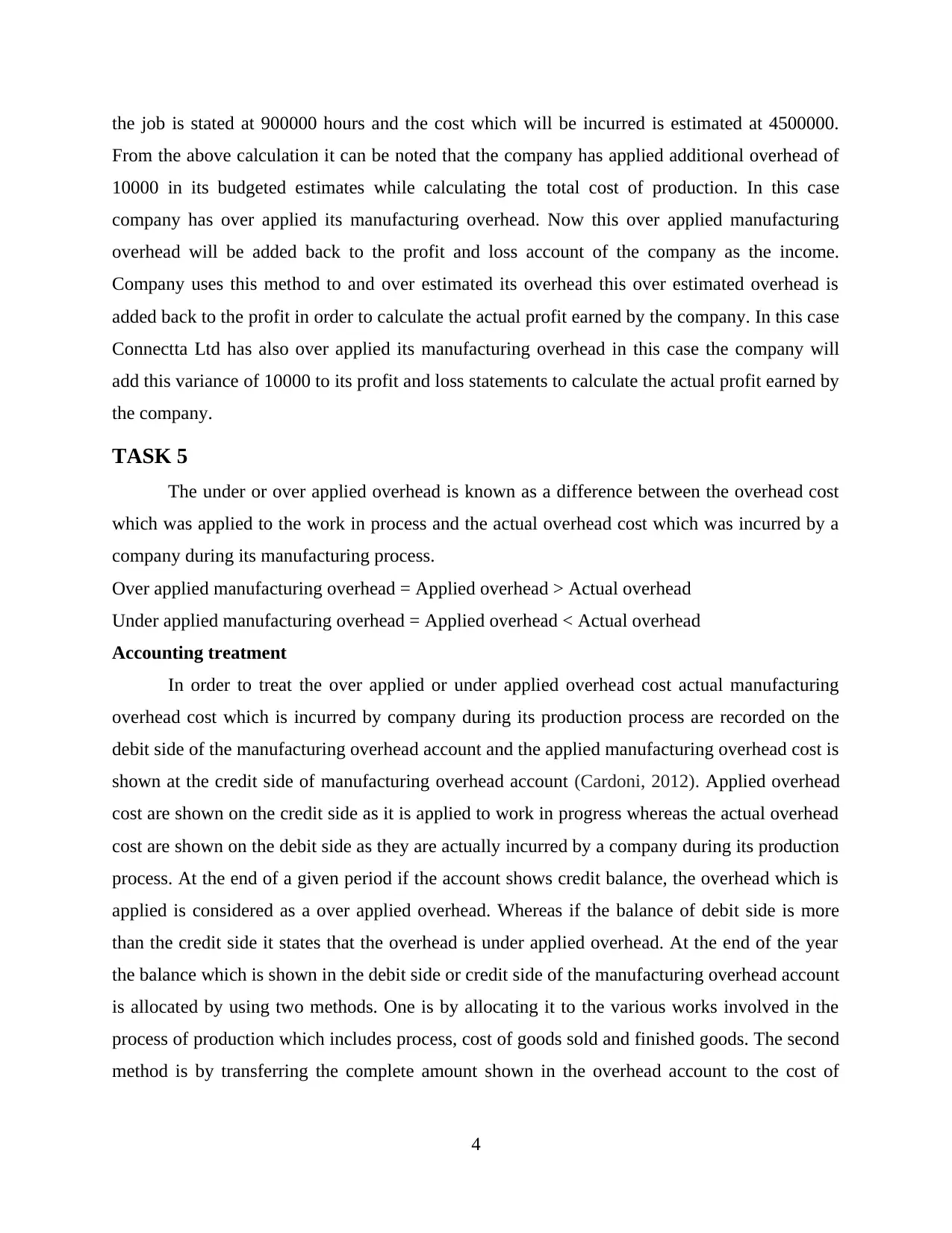
the job is stated at 900000 hours and the cost which will be incurred is estimated at 4500000.
From the above calculation it can be noted that the company has applied additional overhead of
10000 in its budgeted estimates while calculating the total cost of production. In this case
company has over applied its manufacturing overhead. Now this over applied manufacturing
overhead will be added back to the profit and loss account of the company as the income.
Company uses this method to and over estimated its overhead this over estimated overhead is
added back to the profit in order to calculate the actual profit earned by the company. In this case
Connectta Ltd has also over applied its manufacturing overhead in this case the company will
add this variance of 10000 to its profit and loss statements to calculate the actual profit earned by
the company.
TASK 5
The under or over applied overhead is known as a difference between the overhead cost
which was applied to the work in process and the actual overhead cost which was incurred by a
company during its manufacturing process.
Over applied manufacturing overhead = Applied overhead > Actual overhead
Under applied manufacturing overhead = Applied overhead < Actual overhead
Accounting treatment
In order to treat the over applied or under applied overhead cost actual manufacturing
overhead cost which is incurred by company during its production process are recorded on the
debit side of the manufacturing overhead account and the applied manufacturing overhead cost is
shown at the credit side of manufacturing overhead account (Cardoni, 2012). Applied overhead
cost are shown on the credit side as it is applied to work in progress whereas the actual overhead
cost are shown on the debit side as they are actually incurred by a company during its production
process. At the end of a given period if the account shows credit balance, the overhead which is
applied is considered as a over applied overhead. Whereas if the balance of debit side is more
than the credit side it states that the overhead is under applied overhead. At the end of the year
the balance which is shown in the debit side or credit side of the manufacturing overhead account
is allocated by using two methods. One is by allocating it to the various works involved in the
process of production which includes process, cost of goods sold and finished goods. The second
method is by transferring the complete amount shown in the overhead account to the cost of
4
From the above calculation it can be noted that the company has applied additional overhead of
10000 in its budgeted estimates while calculating the total cost of production. In this case
company has over applied its manufacturing overhead. Now this over applied manufacturing
overhead will be added back to the profit and loss account of the company as the income.
Company uses this method to and over estimated its overhead this over estimated overhead is
added back to the profit in order to calculate the actual profit earned by the company. In this case
Connectta Ltd has also over applied its manufacturing overhead in this case the company will
add this variance of 10000 to its profit and loss statements to calculate the actual profit earned by
the company.
TASK 5
The under or over applied overhead is known as a difference between the overhead cost
which was applied to the work in process and the actual overhead cost which was incurred by a
company during its manufacturing process.
Over applied manufacturing overhead = Applied overhead > Actual overhead
Under applied manufacturing overhead = Applied overhead < Actual overhead
Accounting treatment
In order to treat the over applied or under applied overhead cost actual manufacturing
overhead cost which is incurred by company during its production process are recorded on the
debit side of the manufacturing overhead account and the applied manufacturing overhead cost is
shown at the credit side of manufacturing overhead account (Cardoni, 2012). Applied overhead
cost are shown on the credit side as it is applied to work in progress whereas the actual overhead
cost are shown on the debit side as they are actually incurred by a company during its production
process. At the end of a given period if the account shows credit balance, the overhead which is
applied is considered as a over applied overhead. Whereas if the balance of debit side is more
than the credit side it states that the overhead is under applied overhead. At the end of the year
the balance which is shown in the debit side or credit side of the manufacturing overhead account
is allocated by using two methods. One is by allocating it to the various works involved in the
process of production which includes process, cost of goods sold and finished goods. The second
method is by transferring the complete amount shown in the overhead account to the cost of
4
⊘ This is a preview!⊘
Do you want full access?
Subscribe today to unlock all pages.

Trusted by 1+ million students worldwide
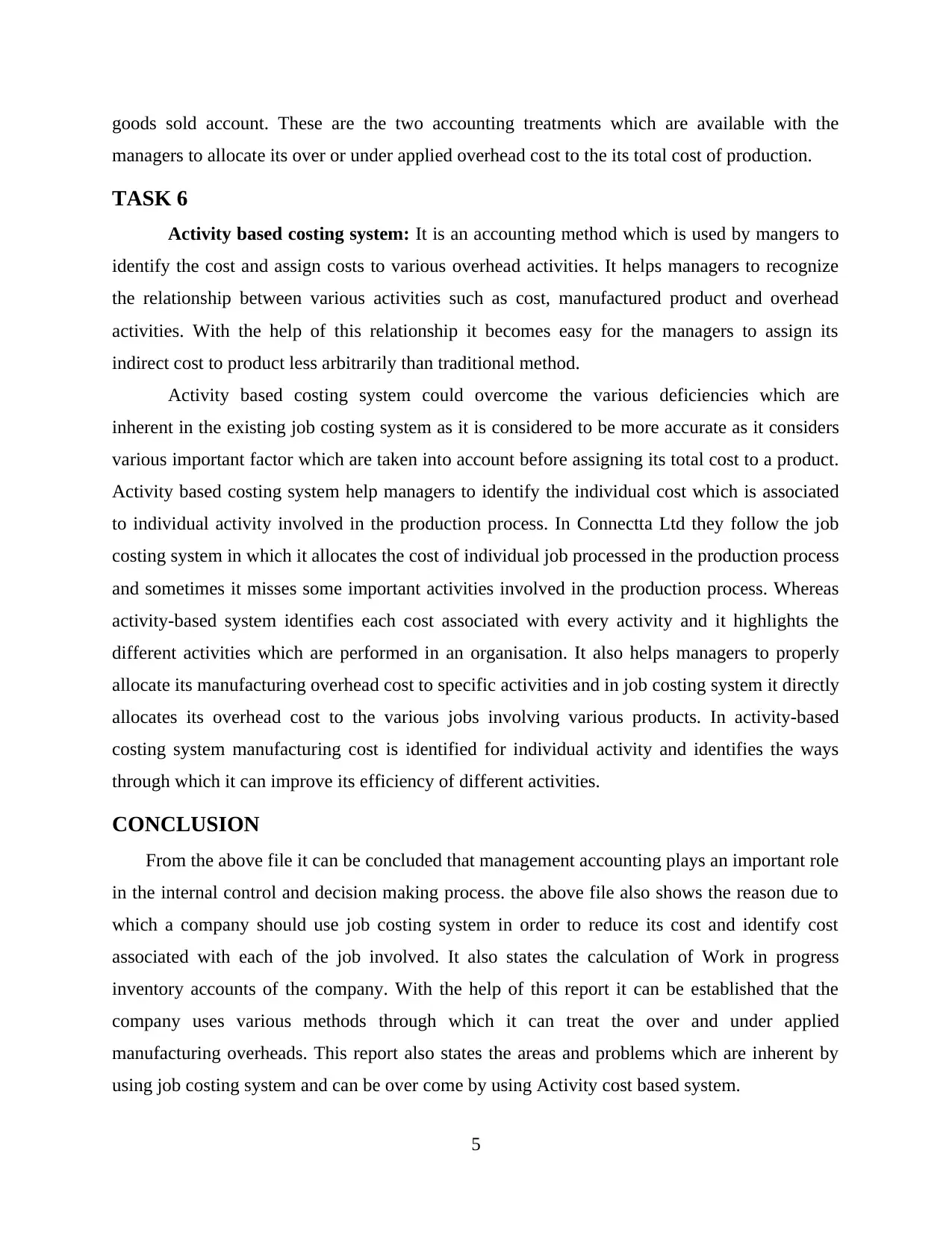
goods sold account. These are the two accounting treatments which are available with the
managers to allocate its over or under applied overhead cost to the its total cost of production.
TASK 6
Activity based costing system: It is an accounting method which is used by mangers to
identify the cost and assign costs to various overhead activities. It helps managers to recognize
the relationship between various activities such as cost, manufactured product and overhead
activities. With the help of this relationship it becomes easy for the managers to assign its
indirect cost to product less arbitrarily than traditional method.
Activity based costing system could overcome the various deficiencies which are
inherent in the existing job costing system as it is considered to be more accurate as it considers
various important factor which are taken into account before assigning its total cost to a product.
Activity based costing system help managers to identify the individual cost which is associated
to individual activity involved in the production process. In Connectta Ltd they follow the job
costing system in which it allocates the cost of individual job processed in the production process
and sometimes it misses some important activities involved in the production process. Whereas
activity-based system identifies each cost associated with every activity and it highlights the
different activities which are performed in an organisation. It also helps managers to properly
allocate its manufacturing overhead cost to specific activities and in job costing system it directly
allocates its overhead cost to the various jobs involving various products. In activity-based
costing system manufacturing cost is identified for individual activity and identifies the ways
through which it can improve its efficiency of different activities.
CONCLUSION
From the above file it can be concluded that management accounting plays an important role
in the internal control and decision making process. the above file also shows the reason due to
which a company should use job costing system in order to reduce its cost and identify cost
associated with each of the job involved. It also states the calculation of Work in progress
inventory accounts of the company. With the help of this report it can be established that the
company uses various methods through which it can treat the over and under applied
manufacturing overheads. This report also states the areas and problems which are inherent by
using job costing system and can be over come by using Activity cost based system.
5
managers to allocate its over or under applied overhead cost to the its total cost of production.
TASK 6
Activity based costing system: It is an accounting method which is used by mangers to
identify the cost and assign costs to various overhead activities. It helps managers to recognize
the relationship between various activities such as cost, manufactured product and overhead
activities. With the help of this relationship it becomes easy for the managers to assign its
indirect cost to product less arbitrarily than traditional method.
Activity based costing system could overcome the various deficiencies which are
inherent in the existing job costing system as it is considered to be more accurate as it considers
various important factor which are taken into account before assigning its total cost to a product.
Activity based costing system help managers to identify the individual cost which is associated
to individual activity involved in the production process. In Connectta Ltd they follow the job
costing system in which it allocates the cost of individual job processed in the production process
and sometimes it misses some important activities involved in the production process. Whereas
activity-based system identifies each cost associated with every activity and it highlights the
different activities which are performed in an organisation. It also helps managers to properly
allocate its manufacturing overhead cost to specific activities and in job costing system it directly
allocates its overhead cost to the various jobs involving various products. In activity-based
costing system manufacturing cost is identified for individual activity and identifies the ways
through which it can improve its efficiency of different activities.
CONCLUSION
From the above file it can be concluded that management accounting plays an important role
in the internal control and decision making process. the above file also shows the reason due to
which a company should use job costing system in order to reduce its cost and identify cost
associated with each of the job involved. It also states the calculation of Work in progress
inventory accounts of the company. With the help of this report it can be established that the
company uses various methods through which it can treat the over and under applied
manufacturing overheads. This report also states the areas and problems which are inherent by
using job costing system and can be over come by using Activity cost based system.
5
Paraphrase This Document
Need a fresh take? Get an instant paraphrase of this document with our AI Paraphraser
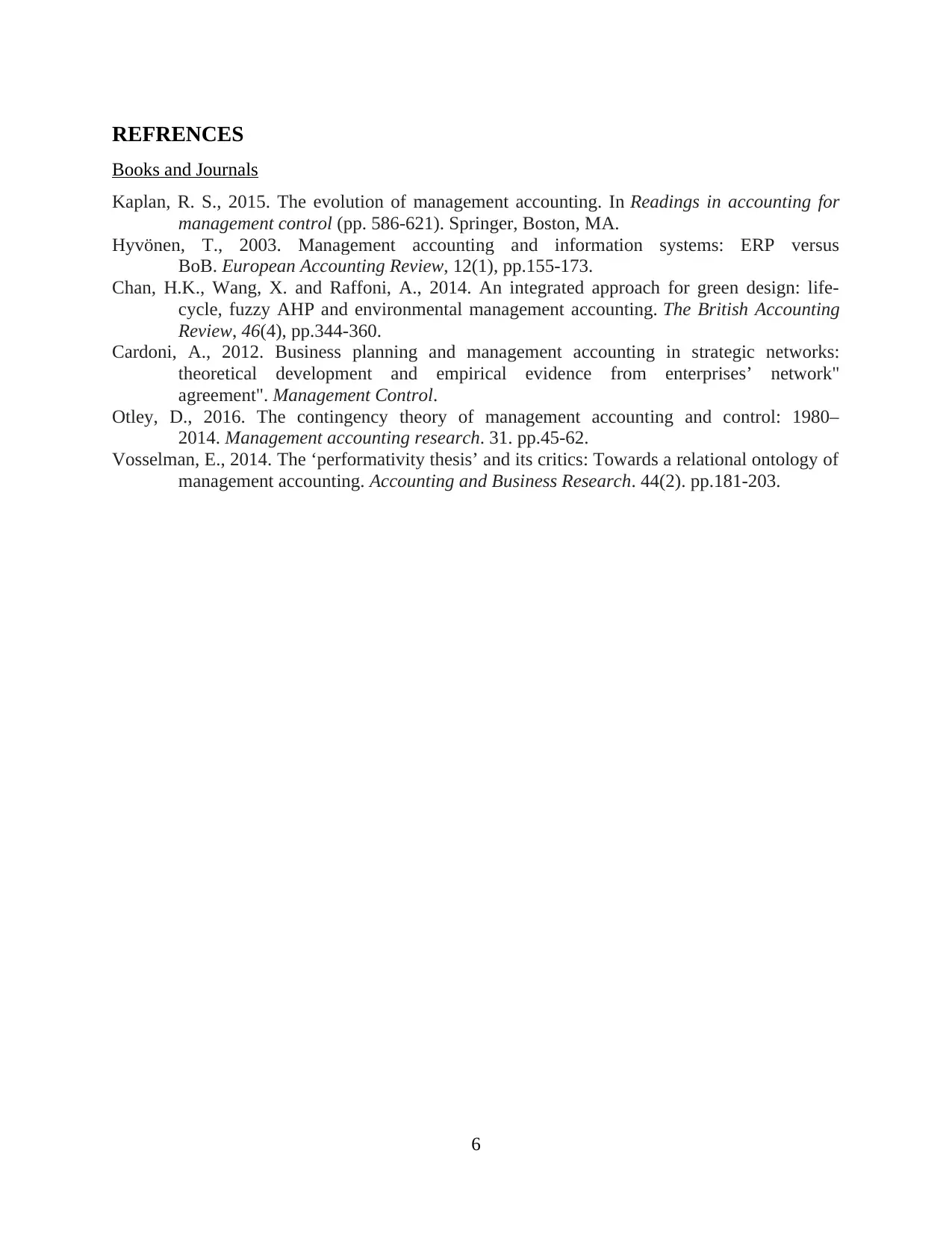
REFRENCES
Books and Journals
Kaplan, R. S., 2015. The evolution of management accounting. In Readings in accounting for
management control (pp. 586-621). Springer, Boston, MA.
Hyvönen, T., 2003. Management accounting and information systems: ERP versus
BoB. European Accounting Review, 12(1), pp.155-173.
Chan, H.K., Wang, X. and Raffoni, A., 2014. An integrated approach for green design: life-
cycle, fuzzy AHP and environmental management accounting. The British Accounting
Review, 46(4), pp.344-360.
Cardoni, A., 2012. Business planning and management accounting in strategic networks:
theoretical development and empirical evidence from enterprises’ network"
agreement". Management Control.
Otley, D., 2016. The contingency theory of management accounting and control: 1980–
2014. Management accounting research. 31. pp.45-62.
Vosselman, E., 2014. The ‘performativity thesis’ and its critics: Towards a relational ontology of
management accounting. Accounting and Business Research. 44(2). pp.181-203.
6
Books and Journals
Kaplan, R. S., 2015. The evolution of management accounting. In Readings in accounting for
management control (pp. 586-621). Springer, Boston, MA.
Hyvönen, T., 2003. Management accounting and information systems: ERP versus
BoB. European Accounting Review, 12(1), pp.155-173.
Chan, H.K., Wang, X. and Raffoni, A., 2014. An integrated approach for green design: life-
cycle, fuzzy AHP and environmental management accounting. The British Accounting
Review, 46(4), pp.344-360.
Cardoni, A., 2012. Business planning and management accounting in strategic networks:
theoretical development and empirical evidence from enterprises’ network"
agreement". Management Control.
Otley, D., 2016. The contingency theory of management accounting and control: 1980–
2014. Management accounting research. 31. pp.45-62.
Vosselman, E., 2014. The ‘performativity thesis’ and its critics: Towards a relational ontology of
management accounting. Accounting and Business Research. 44(2). pp.181-203.
6
1 out of 8
Related Documents
Your All-in-One AI-Powered Toolkit for Academic Success.
+13062052269
info@desklib.com
Available 24*7 on WhatsApp / Email
![[object Object]](/_next/static/media/star-bottom.7253800d.svg)
Unlock your academic potential
Copyright © 2020–2025 A2Z Services. All Rights Reserved. Developed and managed by ZUCOL.





